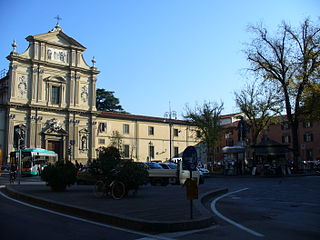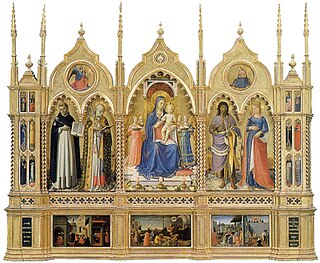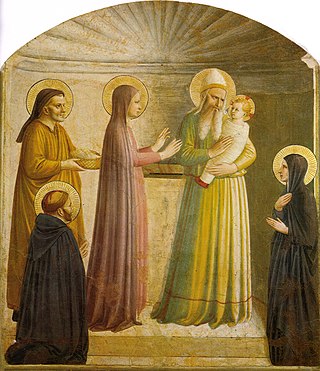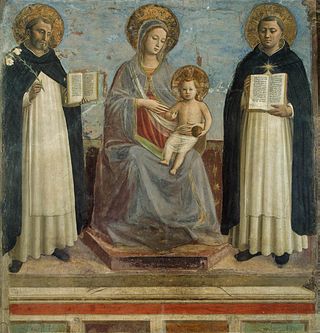
Fra Angelico, OP was a Dominican friar and Italian painter of the Early Renaissance, described by Giorgio Vasari in his Lives of the Artists as having "a rare and perfect talent". He earned his reputation primarily for the series of frescoes he made for his own friary, San Marco, in Florence, then worked in Rome and other cities. All his known work is of religious subjects.

Benozzo Gozzoli was an Italian Renaissance painter from Florence. A pupil of Fra Angelico, Gozzoli is best known for a series of murals in the Magi Chapel of the Palazzo Medici-Riccardi, depicting festive, vibrant processions with fine attention to detail and a pronounced International Gothic influence. The chapel's fresco cycle reveals a new Renaissance interest in nature with its realistic depiction of landscapes and vivid human portraits. Gozzoli is considered one of the most prolific fresco painters of his generation. While he was mainly active in Tuscany, he also worked in Umbria and Rome.

The Descent from the Cross, or Deposition of Christ, is the scene, as depicted in art, from the Gospels' accounts of Joseph of Arimathea and Nicodemus taking Christ down from the cross after his crucifixion. In Byzantine art the topic became popular in the 9th century, and in the West from the 10th century. The Descent from the Cross is the 13th Station of the Cross, and is also the sixth of the Seven Sorrows of the Blessed Virgin Mary.

Museo Nazionale di San Marco is an art museum housed in the monumental section of the medieval Dominican convent of San Marco dedicated to St Mark, situated on the present-day Piazza San Marco, in Florence, a region of Tuscany, Italy.

The San Marco Altarpiece is a painting by the Italian early Renaissance painter Fra Angelico, housed in the San Marco Museum of Florence, Italy. It was commissioned by Cosimo de' Medici the Elder, and was completed sometime between 1438 and 1443.

The Prado Annunciation is an altarpiece painted by the Italian Renaissance painter Giovanni da Fiesole, known as Fra Angelico, in the 1420s. It is one of his best-known works. Originally destined for the convent of the observant Dominicans of Fiesole, the painting is currently in the collection of the Museo del Prado in Madrid. It is one of three altarpieces by Fra Angelico representing the Annunciation; the other two being the Cortona Annunciation and the Annunciation of San Giovanni Valdarno. The sequence in which the three works were painted is not certain, but the general art historical consensus places the Prado version first.

The Coronation of the Virgin is a painting of the Coronation of the Virgin by the Italian early Renaissance painter Fra Angelico, executed around 1432. It is now in the Uffizi Gallery of Florence. The artist executed another Coronation of the Virgin, now in the Louvre in Paris.

The Coronation of the Virgin is a painting by the Italian early Renaissance master Fra Angelico, executed around 1434–1435 in Fiesole (Florence). It is now in the Musée du Louvre of Paris, France. The artist executed another Coronation of the Virgin, now in the Uffizi in Florence.

The Perugia Altarpiece is a painting by the Italian early Renaissance painter Fra Angelico, housed in the Galleria Nazionale dell'Umbria of Perugia, Italy.

The Fiesole Altarpiece is a painting by the Italian early Renaissance master Fra Angelico, executed around 1424–1425. It is housed in the Convent of San Domenico, Fiesole, central Italy. The background was repainted by Lorenzo di Credi in 1501.

The St. Peter of Verona Triptych is a tempera-on-panel painting by the Italian early Renaissance master Fra Angelico, executed around 1428–1429. It is housed in the National Museum of San Marco in Florence, Italy.

Presentazione di Gesù al Tempio is a fresco by Fra Angelico made for the then Dominican Convent of Saint Mark in Florence, Italy. It depicts the dedication of Jesus in the Temple in Jerusalem as the first-born son of His family, as related in the Gospel of St. Luke, 2:23–24. Saint Joseph carries a basket containing two doves as Mary witnesses the Infant Jesus being held by Simeon. This event, the fourth Joyful Mystery of the Rosary, a devotion particularly promoted by the Dominicans, is depicted as being anachronistically witnessed by the Dominican saints Peter of Verona and Catherine of Siena.

San Domenico is a Gothic-style, Roman Catholic church located on via Berrettini in Cortona, region of Tuscany, Italy.

Madonna and Child is a c.1435 fresco fragment by the Italian Renaissance master Fra Angelico in the sacra conversazione style. It was originally painted in the dormitory of the Convent of San Domenico, Fiesole. It was removed from the wall after the convent's suppression during the Napoleonic occupation of Italy and is now in the Hermitage Museum in St Petersburg.

The Croce al Tempio Lamentation is a 1436 or 1440 tempera-on-panel painting by Fra Angelico, now in the Museo nazionale di San Marco in Florence. It is named after its commissioner, the 'Compagnia di Santa Maria della Croce al Tempio'.

The panels of the Armadio degli Argenti are a series of tempera paintings on panel created by Fra Angelico ca. 1451–1453 and completed later by other hands using his preparatory drawings. They are now in the Museo nazionale di San Marco in Florence.
Saint James and Saint Lucy Predella is a circa 1426 to 1428 series of five tempera on panel paintings by Beato Angelico. Together, and possibly with other unknown paintings, they formed the predella to a single altarpiece, now lost or not clearly identified. They are dated on the basis of stylistic motifs and they cannot be later than 1435, when Andrea di Giusto copied Naming in the predella of his own altarpiece now in the Museo civico in Prato.

The Virgin Reliquaries are four 1434 panel paintings by Fra Giovanni Masi after drawings by Fra Angelico, intended as tabernacle-reliquaries for the Convent of Santa Maria Novella. One is in the Isabella Stewart Gardner Museum in Boston whilst the rest are in the Museo nazionale di San Marco in Florence.

Apparition of the Virgin to St Bernard is an oil-on-wood painting by Italian artist Fra Bartolomeo, datable to 1504–1507. It is held in the Uffizi, in Florence.


















